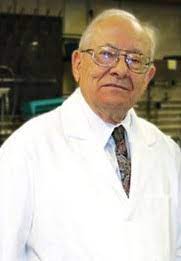
Born in 1924 and approaching his 100th birthday, I’d bet that many of us have had the privilege of sitting at his feet and learning from the best historian/genealogist there is (my opinion!). Author of dozens of books, many on specific state-genealogy, I’d also bet that we’ve had and learned from those text books.
My favorite lecture was one he presented in 1992 at a National Genealogical Society conference. Coming to the lectern in the costume of a Civil War-era town clerk, he proceeded to teach us how to research in counties with burned courthouses in his unique fashion.
As “Carter,” the clerk, he welcomed us and thanked us for coming to the town meeting. “Many of you are tired, having been out late on the bucket brigade last night,” be began, “but we must keep on with county business as best we can.” He thanked all for helping carry boxes of records out of the burning courthouse but “so much stuff was lost.” He continued, “Our meeting today is to try to re-construct our records so to keep our county going!”
“Carter” urged us to bring in our documents and re-register them. Our deeds, marriage certificates (“if your marriage is worth it, he quipped) and any other similar county-important papers. “We’ll get our county going again; a burned courthouse won’t slow us down.”
“Carter” then switched to Dr. Schweitzer and began to explain to us what records existed OUTSIDE of the courthouse that we might turn to for our research.
- Title companies – this office has records of all deeds and land grants in the county
- Judical records – West’s Decennial Index lists cases that have ben appealed from the county
- Law offices – files of cases and client work exist, including wills, mortgages, appeals, etc.
- Cemetery – tombstones have names and dates and there are on file deeds to cemetery plots
- Church records – some churches kept good “people records” and others not so much
- Fraternal Societies – Masonic, DAR, Woodmen of the World, Elks, Eastern Star, GAR, UCW, etc.
- Funeral director – lots of files!
- Newspapers – always full of obits, accidents, marriages, anniversaries and “run-away wives”
- School records – schools received state money based on student attendance, so records were kept
Dr. Schweitzer, once again as “Carter,” town clerk, finished his talk with this: “We’re gonna save what wasn’t burned but where are these records today? We’re gonna re-construct the records and you’ll discover there ain’t hardly nothing in the burned courthouse that’s plum GONE.”
Great article. I had never heard of Dr. George Schweitzer. Loved the reenactment part. Why after all these years had I not heard of him? Thanks Donna for a good read.
I too saw him several times at the Tacoma-Pierce County Gen. Society. What a hoot. In this talk, his clerk image was covered in soot! His costume changes were legendary. He could go from mountain man to Southern Rebel to Northern soldier in a snap. He was extremely entertaining and I am sad he is not appearing anymore, but happy he has lived a wonderfully long life.
Sylvia H. Nelson, BIGS
Thank you for the great info. What a hero